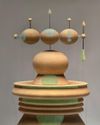
It is here that the beautiful cloth paintings known as the pichvai took birth.
These artists settled behind the temple in what is known today as the chitrakaron ki gali (artists' street). This is unique, even in a place like India, which has seen the survival of many artistic traditions from the past. Even today, over 300 artists continue to live and practise their art in Nathdwara, keeping this 300-year-old tradition alive.
This special Art issue of AD is dedicated to these artists, as it is to Suresh Sharma, the artist who painted this Morakuti (peacock) pichvai cover especially for AD, a contemporary version inspired by designer Vikram Goyal's brass repousse panels, which in turn are inspired by the traditional Morakuti pichvais of Nathdwara.
Suresh is also one of the founders of the Artists of Nathdwara (AoN), an organization founded in 2015 with the mission of promoting the authentic traditions of the painted pichvai across the world-and to bring its beauty to us all.
The temple town of Nathdwara in Rajasthan has grown around the haveli of Shrinathji, the principal devotional image for the Vaishnava Pushti Marg (the Path of Grace) sect, that was brought here from Vraj (present-day Vrindavan region) in 1672. By the late 15th and the early part of the 16th century, a very powerful devotional (bhakti) movement had developed around Krishna and some of the sacred sites associated with his early life around the banks of the river Yamuna.
Krishna is said to have appeared before the founder of the sect, Vallabhacharya (1479-1531), a Brahmin from the Andhra region, and commanded him to go to Mount Govardhan where he discovered the svarup (the living image of Krishna) of Shri Govardhananathji, who came to be known as Shrinathji to his followers.
هذه القصة مأخوذة من طبعة January - February 2023 من AD Architectural Digest India.
ابدأ النسخة التجريبية المجانية من Magzter GOLD لمدة 7 أيام للوصول إلى آلاف القصص المتميزة المنسقة وأكثر من 9,000 مجلة وصحيفة.
بالفعل مشترك ? تسجيل الدخول
هذه القصة مأخوذة من طبعة January - February 2023 من AD Architectural Digest India.
ابدأ النسخة التجريبية المجانية من Magzter GOLD لمدة 7 أيام للوصول إلى آلاف القصص المتميزة المنسقة وأكثر من 9,000 مجلة وصحيفة.
بالفعل مشترك? تسجيل الدخول

AS NEW DELHI'S GALLERY ESPACE MARKS ITS 35TH ANNIVERSARY, AD LOOKS AT GALLERIST RENU MODI'S JOURNEY IN ART.
The New Delhi-based Gallery Espace, founded by Renu Modi in 1989, recently marked its 35th anniversary with two special exhibitions.

ROCHELLE PINTO, EDITOR OF VOGUE INDIA, WRITES ABOUT FORCES OF FASHION, WHICH PUT 39 UNIQUE WORKS UNDER ONE ROOF, PIECING TOGETHER A SHORT HISTORY OF FASHION IN INDIA.
If you want to step into the mind of Cristóbal Balenciaga, the game-changing Spanish couturier who died over 50 years ago, all you have to do is beg, bribe or charm your way into 10 Avenue George V in Paris.

AS INVISIBLE COLLECTION COMES TO INDIA, FOUNDERS ISABELLE DUBERNMALLEVAYS AND LILY FROEHLICHER SHARE THEIR SERENDIPITOUS JOURNEY TO THE COUNTRY.
Isabelle Dubern-Mallevays and Lily Froehlicher first found India at their doorstep when Sonam Kapoor Ahuja borrowed a few pieces from their collection for an AD India cover story in 2021.

ANONYMOUS ARTIST PRINCESS PEA SHOWCASES A COLLECTION OF NINE NEW PRINTS AT THE SOHO HOUSE LOUNGE AT ART MUMBAI.
In Princess Pea's new collection of works, poetry, craft and the divine femininity coalesce with grace.

ARTISTS RITU AND SURYA SINGH'S WONDERLAND OF A HOMESTUDIO IN THE PINK CITY URGES YOU TO LOOK AT THE BEAUTY AND NARRATIVE OF WASTE.
Husband-wife artist duo Ritu and Surya Singh, better known as Wolf, live at \"The Farm\", a unique 20-acre madhouse of wonders in the heart of Jaipur.

KENGO KUMA TALKS TO AD ABOUT HIS DESIGN ADDITIONS AS THE CENTRO DE ARTE MODERNA GULBENKIAN IN LISBON OPENS ITS DOORS AGAIN.
Everyone who has lived in Lisbon likely has a fond memory of the Gulbenkian complex.

FROM HIS REVERENCE FOR GANDHI TO HIS LOVE OF DANCE, A BOOK BY DAG OFFERS NEW WAYS TO KNOW MF HUSAIN.
If there was ever an Indian artist who earned immense fame and yet remained unknowable, it is MF Husain.

WHAT WOULD BAWA DO? WONDERS APARNA RAO, COFOUNDER OF PHANTOM HANDS, AS SHE PRODUCES REISSUES OF GEOFFREY BAWA'S HIGHLY CONTEXTUAL FURNITURE.
In mid-December last year, in the freshly restored Kannangara House designed by Geoffrey Bawa in 1959, an exhibition based on the late Sri Lankan master's furniture designs opened.

BANGLADESHI ARTIST AYESHA SULTANA'S RECENT DUBAI EXHIBITION EXPLORED THE DUAL NATURE OF STRENGTH AND FRAGILITY.
Born in Bangladesh in 1984, the US-based Ayesha Sultana explores notions of form, space and materiality.

WE CATCH UP WITH TARIK CURRIMBHOY AT HIS STUDIO IN NEW YORK, AFTER HIS FIRST SOLO SHOW IN INDIA.
Tarik Currimbhoy's sculptures have a pure, meditative quality. A viewer can stand mesmerized for hours watching the elegant, geometric shapes move back and forth.